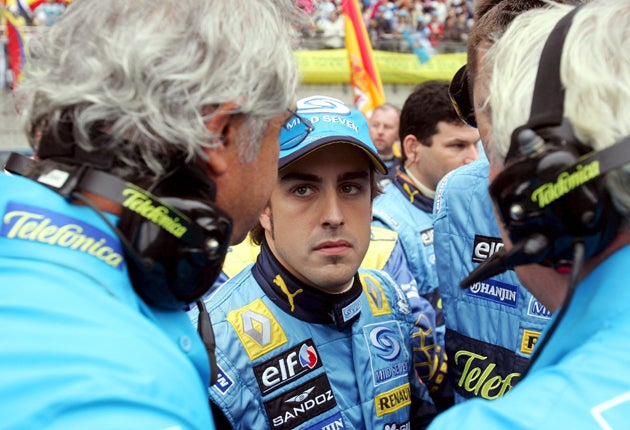Doubts remain over Alonso role in race-fixing scandal

Your support helps us to tell the story
From reproductive rights to climate change to Big Tech, The Independent is on the ground when the story is developing. Whether it's investigating the financials of Elon Musk's pro-Trump PAC or producing our latest documentary, 'The A Word', which shines a light on the American women fighting for reproductive rights, we know how important it is to parse out the facts from the messaging.
At such a critical moment in US history, we need reporters on the ground. Your donation allows us to keep sending journalists to speak to both sides of the story.
The Independent is trusted by Americans across the entire political spectrum. And unlike many other quality news outlets, we choose not to lock Americans out of our reporting and analysis with paywalls. We believe quality journalism should be available to everyone, paid for by those who can afford it.
Your support makes all the difference.The Renault Formula One team will learn within the next two days what punishment the World Motor Sport Council decide to mete out as an extraordinary meeting in Paris investigates the fixing of the result at the 2008 Singapore Grand Prix.
Earlier this week, team principal Flavio Briatore and engineering chief Pat Symonds resigned from the company. The latter has maintained silence over the matter, while Briatore lost no time seeking to excuse his role in the scandal and to rehabilitate himself. "I was just trying to save the team. It's my duty. That's the reason I've finished," he said.
Renault have said they will not dispute the charges of race-fixing – tantamount to admitting their guilt. They have thrown themselves on the leniency of the court now that two of the three men involved had quit – the third being driver Nelson Piquet Jnr, who deliberately crashed his car so the team leader, Fernando Alonso, could benefit from a safety-car period and win the race at a time when Régie Renault were seriously reconsidering whether to remain within the sport after a string of poor results.
It is irrelevant whether Briatore and Symonds were pushed or chose to fall on their swords. As the architects of the plan, there was no way they could stay. What matters now is whether the court decides that showing them the door represents sufficient action, or whether it decides that Renault should be hit with a ban from competing in next year's World Championship, or handed a fine such as the $100m with which McLaren were hit back in the Stepneygate spy scandal of 2007 when much less was proved against that team than is alleged against Renault.
Two years ago, to general disbelief, Renault walked free from a similar spying claim – even though McLaren's intellectual property, including the crucial "J" damper which revolutionised suspension behaviour, was so deeply embedded in their computer system that it remains there to this day.
In among all the hoopla, there is a question that is now being asked in some quarters: was Fernando Alonso completely unaware of the strategy that Briatore, Symonds and Piquet Jnr are said to have hatched to his ultimate benefit?
Alonso has maintained his silence over the race-fixing allegations but he made a statement at Spa to the race stewards, their chairman Alan Donnelly, an FIA observer and external advisers from Sidley Austin LLP and Quest who were employed on the governing body's behalf, in which he said he had no knowledge of any meetings between Briatore, Symonds and Piquet Jnr, and that he usually left strategy to his engineers. Alonso also stated that an early and aggressive refuelling strategy – he stopped on the 12th lap – was consistent with trying to gain an advantage after a poor qualifying, when running the same strategy as the 14 rivals ahead of him on the grid would not have presented him with much chance of progress.
It is thought that Alonso was offered similar immunity from prosecution to that which Piquet was given to spill the beans, and which Symonds was offered, just as the Spaniard was during the Stepneygate scandal.
In Piquet's case, that conveniently bypasses the crucial safety issue at the heart of the incident. Formula One might have had an impressive record since the deaths at Imola in 1994 of Roland Ratzenberger and Ayrton Senna, but marshals Paolo Ghislimberti and Graham Beveridge were killed at Monza in 2000 and Melbourne in 2001 respectively by flying debris, and Renault themselves only narrowly escaped exclusion from the Belgian GP after Alonso was released from the pits with a loose front wheel in the Hungarian GP, only a week after an errant wheel had killed Henry Surtees in a Formula Two race at Brands Hatch in July. A deliberate accident exacerbated similar risk.
"If it puts human life at risk, whether it's the spectators, the marshals or the drivers, then it's more serious again," the FIA president Max Mosley said in Monza last weekend.
Triple world champion Niki Lauda, who came close to death in a crash in Germany in 1976, said: "I would never have crashed on order: firstly, because sport is sport and secondly, because in my day I could have hurt or killed myself. My Nürburgring crash was big. I got straight back in and drove as soon as I could. Others were not so lucky. Some died. We do not want a sport where we are putting lives at risk for all the worst reasons."
Join our commenting forum
Join thought-provoking conversations, follow other Independent readers and see their replies
Comments